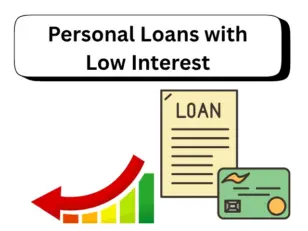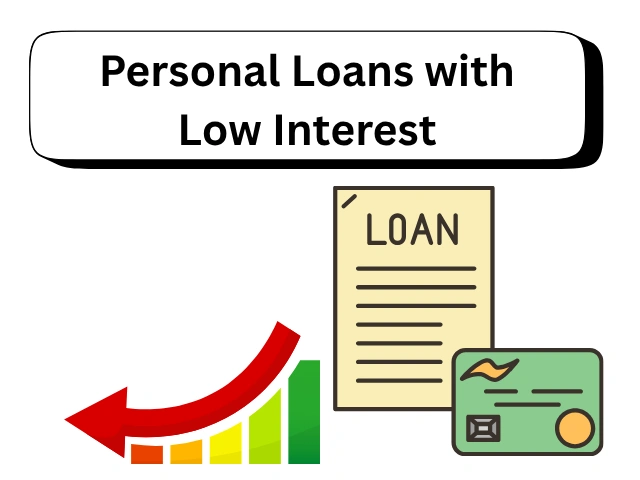Discover the best personal loans USA offers with low interest rates. Learn about types, benefits, and why interest rates matter before applying.
If you are looking for financial flexibility in the USA, choosing personal loans with low interest can save you a lot of money over time. Personal loans can help cover emergencies, consolidate debt, fund home improvements, or finance major purchases. With a variety of lenders and loan types available, finding the right personal loans USA option can be overwhelming. The interest rate you secure can make a huge difference in total repayment, monthly payments, and your overall financial health. This guide will help you understand what personal loans are, the different types available, and why securing a low-interest loan is crucial.
What is a Personal Loan?
A personal loan is an unsecured loan provided by banks, credit unions, or online lenders. Unlike mortgages or auto loans, personal loans usually don’t require collateral, meaning you don’t have to pledge an asset to borrow money.
Key Features of Personal Loans
- Fixed Amount: Borrow a specific amount upfront
- Fixed Term: Typically 12 to 60 months for repayment
- Fixed or Variable Interest Rate: Some loans offer fixed rates, while others may vary
- Monthly Payments: Paid in equal installments
Personal loans can help consolidate high-interest debts, cover unexpected expenses, or fund major life events without tapping into credit cards.
Types of Personal Loans
Understanding the types of personal loans available in the USA helps you choose the right one:
1. Unsecured Personal Loans
- Most common type of personal loan
- No collateral required
- Interest rates vary based on credit score
- Perfect for debt consolidation or emergencies
2. Secured Personal Loans
- Requires collateral like a car, savings account, or property
- Lower interest rates than unsecured loans
- Lender can seize collateral if you default
3. Fixed-Rate Loans
- Interest rate remains constant throughout the loan term
- Easier to plan monthly payments
- Ideal for borrowers who want predictable repayments
4. Variable-Rate Loans
- Interest rate can change based on market conditions
- May start lower than fixed rates, but can increase over time
- Suitable for borrowers expecting stable or increasing income
5. Debt Consolidation Loans
- Combines multiple debts into a single loan
- Can reduce overall interest payments if the consolidation loan has a lower rate
- Helps simplify financial management
Why Interest Rate Matters
The interest rate is the cost of borrowing money. Even a small difference in rates can significantly impact the total repayment.
Example:
- Loan Amount: $10,000
- Loan Term: 3 years (36 months)
| Interest Rate | Monthly Payment | Total Repayment |
| 5% | $299 | $10,764 |
| 10% | $322 | $11,592 |
| 15% | $347 | $12,492 |
Observation: A 5% difference in interest rate can cost almost $1,800 extra over 3 years!
Securing personal loans USA with low interest ensures you pay less and manage monthly payments comfortably.
Step-by-Step Guide to Getting Low-Interest Personal Loans
If you want the best personal loans USA offers with low interest, following a systematic approach can help you secure favorable terms.
1. Check Your Credit Score
- Your credit score is a key factor in determining interest rates.
- Higher scores (700+) usually qualify for lower interest rates.
- Obtain free credit reports from Equifax, Experian, and TransUnion.
2. Determine Your Loan Amount and Purpose
- Decide how much you need and why.
- Personal loans are ideal for:
- Debt consolidation
- Home improvement
- Emergency expenses
- Large purchases
3. Compare Lenders
- Banks, credit unions, and online lenders offer different rates.
- Look for:
- Fixed or variable rates
- Fees (origination, late payment, prepayment penalties)
- Repayment terms
4. Prequalify Online
- Many lenders allow soft inquiries to estimate your eligibility.
- Prequalification doesn’t affect your credit score.
- Helps compare multiple lenders before applying.
5. Gather Required Documents
- Valid ID (Driver’s License or Passport)
- Proof of income (pay stubs, tax returns)
- Employment verification
- Bank statements
6. Submit Application
- Apply with the lender offering the best terms.
- Ensure all information is accurate to avoid delays.
7. Review and Accept Terms
- Check interest rate, repayment schedule, fees, and penalties.
- Accept only if terms are favorable and affordable.
Tips to Qualify for Low-Interest Personal Loans
1. Improve Credit Score Before Applying
- Pay down high balances
- Avoid late payments
- Reduce credit utilization
2. Consider Credit Unions
- Credit unions often offer lower interest rates than banks.
- Membership eligibility may apply.
3. Opt for Secured Loans if Needed
- Collateral can reduce risk for lenders, leading to lower rates.
4. Choose Shorter Loan Terms
- Shorter repayment terms often have lower interest rates.
- Monthly payments may be higher but save interest in the long run.
5. Avoid Multiple Applications at Once
- Too many hard inquiries lower your score.
- Apply selectively after comparing lenders.
Common Mistakes to Avoid
1. Ignoring Fees
- Some lenders advertise low rates but charge high origination or prepayment fees.
2. Borrowing More Than Needed
- Increases debt and interest payments unnecessarily.
3. Missing Payments
- Late payments can raise interest rates and harm your credit score.
4. Choosing Long Terms Without Calculating Interest
- Longer terms reduce monthly payments but increase total interest paid.
Typical Personal Loan Interest Rates in the USA (2025)
| Loan Type | Average APR (%) | Notes |
| Unsecured Personal Loan | 10–20% | Depends on credit score |
| Secured Personal Loan | 5–12% | Lower rates due to collateral |
| Credit Union Loan | 6–14% | Often lower than banks |
| Online Lender | 7–24% | Fast approval, varies by credit |
Observation: Secured loans and credit union loans often offer the lowest rates, while online lenders may vary depending on creditworthiness.
Advanced Strategies to Secure Low-Interest Personal Loans
1. Opt for a Secured Loan if Possible
- Secured loans require collateral such as a car, savings account, or certificate of deposit.
- Lenders view these as lower risk, often offering lower interest rates.
- Ideal for borrowers with lower credit scores aiming for affordable repayment.
2. Leverage Your Relationship with Your Bank or Credit Union
- Long-term customers may qualify for preferential rates.
- Ask about special discounts, loyalty programs, or member rates.
3. Improve Your Credit Score Before Applying
- Pay down high balances
- Avoid late payments
- Check credit reports for errors
- A higher credit score can save hundreds or thousands in interest.
4. Choose Shorter Repayment Terms
- Shorter terms reduce total interest paid.
- Monthly payments may be higher, but long-term savings are significant.
5. Consider Automatic Payments
- Many lenders offer interest rate reductions for autopay enrollment.
- Ensures timely payments, which protects your credit score.
Real-Life Examples of Low-Interest Personal Loans
Example 1: Sarah – Debt Consolidation Success
Sarah had multiple high-interest credit cards. She:
- Applied for a personal loan USA from her credit union at 6.5% APR
- Consolidated $15,000 of debt into one loan
- Paid off in 3 years
Result: Saved $2,500 in interest compared to her previous cards.
Example 2: Michael – Home Improvement Loan
Michael wanted to renovate his kitchen. He:
- Took a $12,000 unsecured loan from an online lender at 9.5% APR
Compared multiple lenders to find the lowest rate
Result: Completed renovation affordably and paid off loan in 2 years.
Example 3: Emma – Emergency Medical Expenses
Emma faced unexpected medical bills. She:
- Applied for a secured personal loan using her savings as collateral
- Secured a 5% interest rate, much lower than credit cards
Result: Covered bills without high interest and maintained credit score.
FAQs About Personal Loans USA
1. What is the average personal loan interest rate in the USA?
- Unsecured loans: 10–20% APR
- Secured loans: 5–12% APR
- Rates depend on credit score, lender, and loan type
2. Can I get a personal loan with bad credit?
- Yes, but interest rates will be higher
- Secured loans or credit union loans are good options
3. How much can I borrow with a personal loan?
- Typically $1,000–$50,000
- Depends on income, credit score, and lender policies
4. Does applying for multiple loans hurt my credit?
- Each hard inquiry can slightly lower your score
- Apply selectively and after comparing lenders
5. Are there fees associated with personal loans?
- Some loans have origination fees (1–5% of loan amount)
- Late payment or prepayment penalties may apply
6. Can I pay off a personal loan early?
- Most lenders allow early repayment
- Check for prepayment penalties
- Paying early can save on interest
7. How do I qualify for the lowest interest rate?
- Maintain high credit score
- Apply with credit unions or reputable banks
- Consider secured loans or shorter terms
Final Thoughts
Securing personal loans USA with low interest requires research, preparation, and smart financial decisions. Key takeaways:
- Check your credit score and improve it before applying.
- Compare multiple lenders to find the lowest rates and best terms.
- Consider secured loans or credit union options for better rates.
- Avoid multiple applications at once and unnecessary fees.
- Use personal loans responsibly for debt consolidation, emergencies, or major purchases.
With these strategies, you can save money on interest, simplify your finances, and achieve your goals faster. Remember, the right personal loan is more than just borrowing—it’s a tool to improve financial stability and build a strong credit profile.

